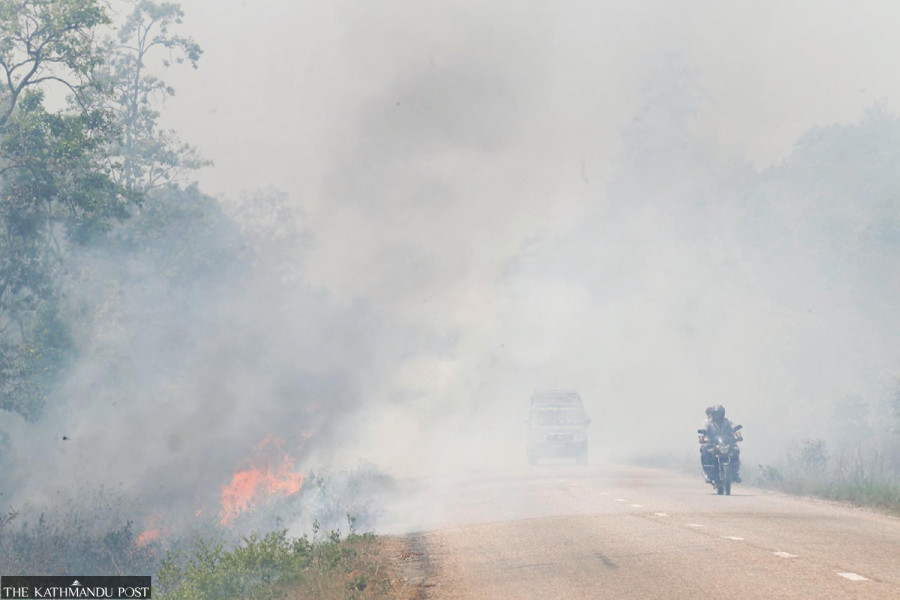Climate & Environment
Nepal’s forests vulnerable to increasingly fierce fires
Scientists say the worse could be yet to come as the winter season in Nepal becomes hotter and drier.
Arpan Shrestha
Spring is the season of dadhelo (wildfire).
Dry and burning eyes, irritated nose and sinus, sore throat, wheezing cough and difficulty breathing—the spring of 2021 unleashed a public health emergency amid the Covid-19 pandemic. It affected everyone and increased health risks in children, the elderly and those with chronic respiratory conditions.
Hospitals saw an uptick in patients with respiratory and allergy cases as the air quality spiked from ‘Very Unhealthy’ to ‘Hazardous’. The government closed schools and advised the public to avoid the outdoors and close the windows. Authorities also cancelled domestic flights due to a lack of visibility and citizens posted experiences, videos and photographs on social media, offering a dystopian look at life under climate crisis.
For weeks, a thick layer of toxic smog blanketed much of Nepal. It blocked the sun and elevated air pollution levels so severely that indoor air quality worsened. The source of this unusual air pollution that ranked the world’s worst for days was Nepal’s forests, which were going up in smoke as a record number of fierce wildfires following an unusually dry winter spread uncontrolled throughout the country, including in conservation areas, national parks and hunting reserves along the northern border.
One thing was certain when the wildfires and severe air pollution subsided with the rain last year. The country’s valuable forests, which took more than six decades of restoration, face a worsening wildfire reality with scarce resources and zero strategies to prevent or contain them. As seasons get unpredictable on a warming planet, resulting in extreme wet and dry conditions, scientists say, the worse could be yet to come as the winter season in Nepal becomes hotter and drier.
“The winter season is usually dry but it has worsened over the years. It’s hotter than before with a decreasing trend of precipitation rate,” said Dr Indira Kandel, a senior divisional meteorologist and chief of the Climate Analysis Section at the Department of Hydrology and Meteorology. “A hot and dry winter sets ideal conditions for smog and a high probability of massive wildfires in the spring.”
While there’s a dearth of study to confirm the climate crisis-driven trend of worsening wildfires in Nepal, the preceding conditions during the fall and winter seasons for the years which saw increased frequency and fierce wildfires indicate that hotter and drier climate post-monsoon season creates conditions that are conducive to the spread of wildfires, including in high altitude regions.
Studies also show Nepal’s predominantly dry climate is getting hotter and drier. The average annual maximum temperature has increased by 0.056C, according to a 2017 study by the MET office. The number of hot days has increased while the number of cold days has decreased. The country is also experiencing intense heatwaves lately and the winter season has been getting hotter and drier, which has become a trend in recent years, according to Kandel.
Several studies over the past decade have also warned how a warming climate can affect precipitation rates resulting in extremely wet conditions in some regions while drier in others or both in some areas, as witnessed in Nepal. A 2019 report by the Ministry of Forests and Environment also projects that the mean temperature for all seasons in Nepal will increase by 1.7C to 3.6C by 2100.
The fierce wildfires that ravaged the country in the spring of 2021—2,713 incidents in 73 districts—followed an exceptionally dry winter, as forecast by the MET office in its Winter Climate Outlook. Maximum temperatures, MET data show, shot up at many stations by as much as 6C to 9C while the country received scant rain and snow in pocket areas in contrast to the winter of 2020, which saw higher than normal rainfall across the country.
“There has been no rainfall this year since the monsoon retreated. The outlook for this winter also looks hot and dry overall, with higher than normal temperature and less than normal precipitation,” said Kandel. “We need a Plan B to respond to these unpredictable seasons that increase the risk of devastating wildfires and impact agriculture and water availability.”
Wildfires are common in Nepal during the dry season between October and May. They may occur naturally or through human activities and errors but hotter and drier conditions turn them fierce and uncontrollable by adding fuel to the fire, quite literally.
“Prolonged hot and dry conditions dry the treeline, bushes and vegetation in the forest bed, making them highly flammable. Forests then fuel the incoming wildfires. All it takes is a spark,” said Pramod Bhattarai, chief conservation officer at Langtang National Park. “Wildfires then spread quickly and scorch forests, causing devastating and sometimes, irreversible damage to the environment and our precious flora and fauna.”
While the full extent of loss and damage caused by wildfires is unknown due to the lack of reliable data, online platforms that use satellite data offer some hard figures. From 2001 to 2021, according to Global Forest Watch, Nepal lost 6.78 kilohectares (kha) of tree cover from wildfires and 44.6kha from all other loss drivers. Wildfires were responsible for 13% of tree cover loss in Nepal in the same period, with the highest tree cover loss in the mid-western region, which saw an average of 120ha loss per year.
The most significant loss due to wildfires was recorded in 2009 when NASA’s satellite spotted large-scale forest fires in mountain regions, a relatively rare event then. That year, wildfires scorched 1.33kha of tree cover, accounting for 24 percent of all tree cover loss.
Birkha Bahadur Shahi, general secretary of the Federation of Community Forestry Users, Nepal, which oversees 22,519 forests across the country, is concerned about the loss of forests to wildfires. However, he believes that community ownership and economic incentives, the underlying principles of forest restoration in Nepal, can help prevent wildfires and reduce loss and damage.
“Awareness and prevention are the two tools we have to fight wildfires. We can’t do much about the hot and dry climate, which is causing less rain and delayed snowfall but human activities cause 90 percent of wildfires in Nepal,” said Shahi. “That’s where we need to intervene to prevent loss and damage.”
With last year’s fierce fire still fresh in his memory, Bhattarai, who has encountered wildfires across Nepal’s diverse terrain all his life, calls for increased intervention and scientific wildfire management as wildfires become more frequent and more destructive.
A total of 25 hectares of forest in Langtang National Park was destroyed by wildfires last year, as reported by the National News Agency, but there is no clear audit of the ecological and economic damage or loss of wildlife and their habitat in Langtang or across the country because wildfires haven’t received the focus and priority it should despite the damages, according to Bhattarai.
“Wildfire has emerged as the single biggest threat to Nepal’s forests and their biodiversity in the wake of hot and dry climate. It is next to impossible to contain the wildfires in remote and difficult terrain,” said Bhattarai. “We pray for rain.”




 16.12°C Kathmandu
16.12°C Kathmandu











